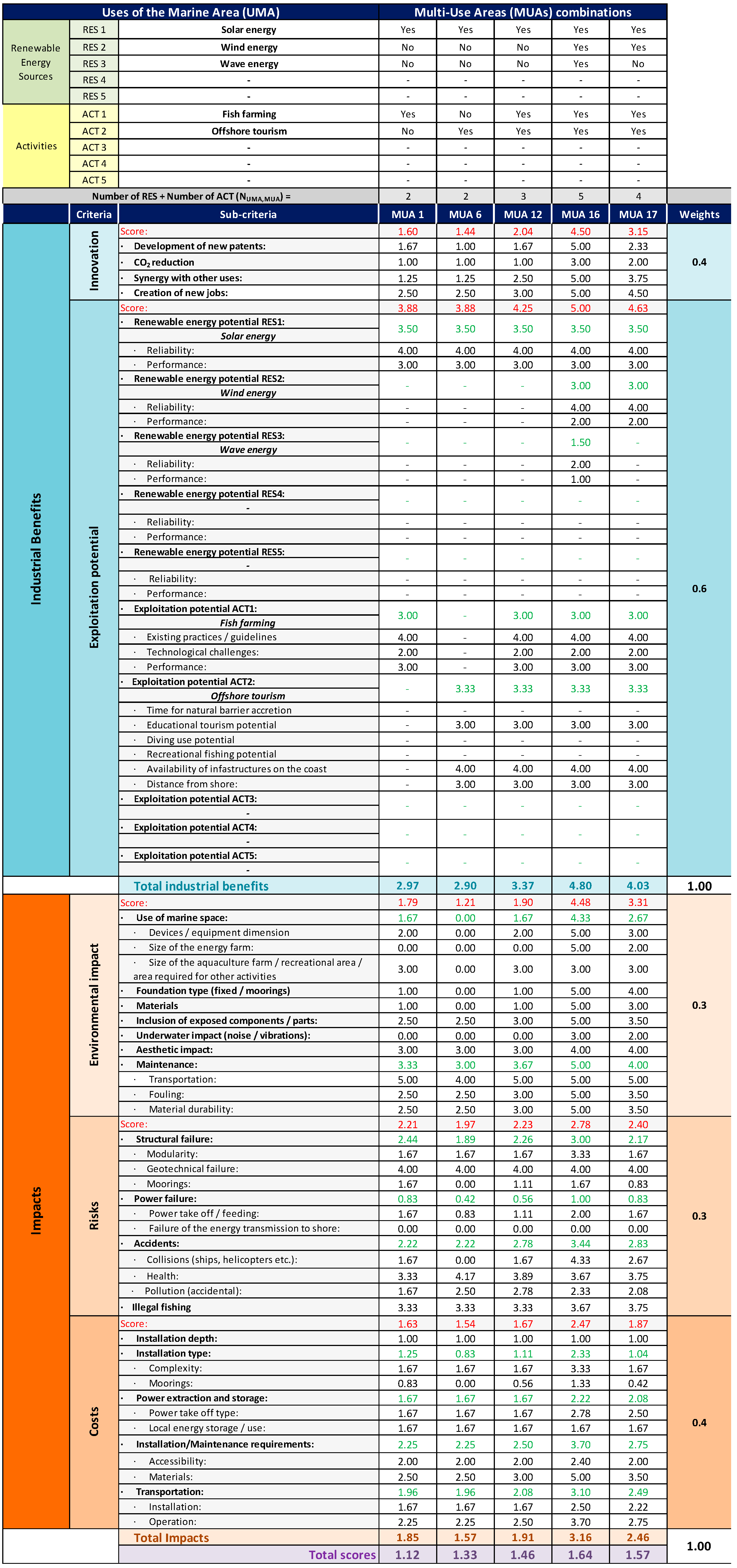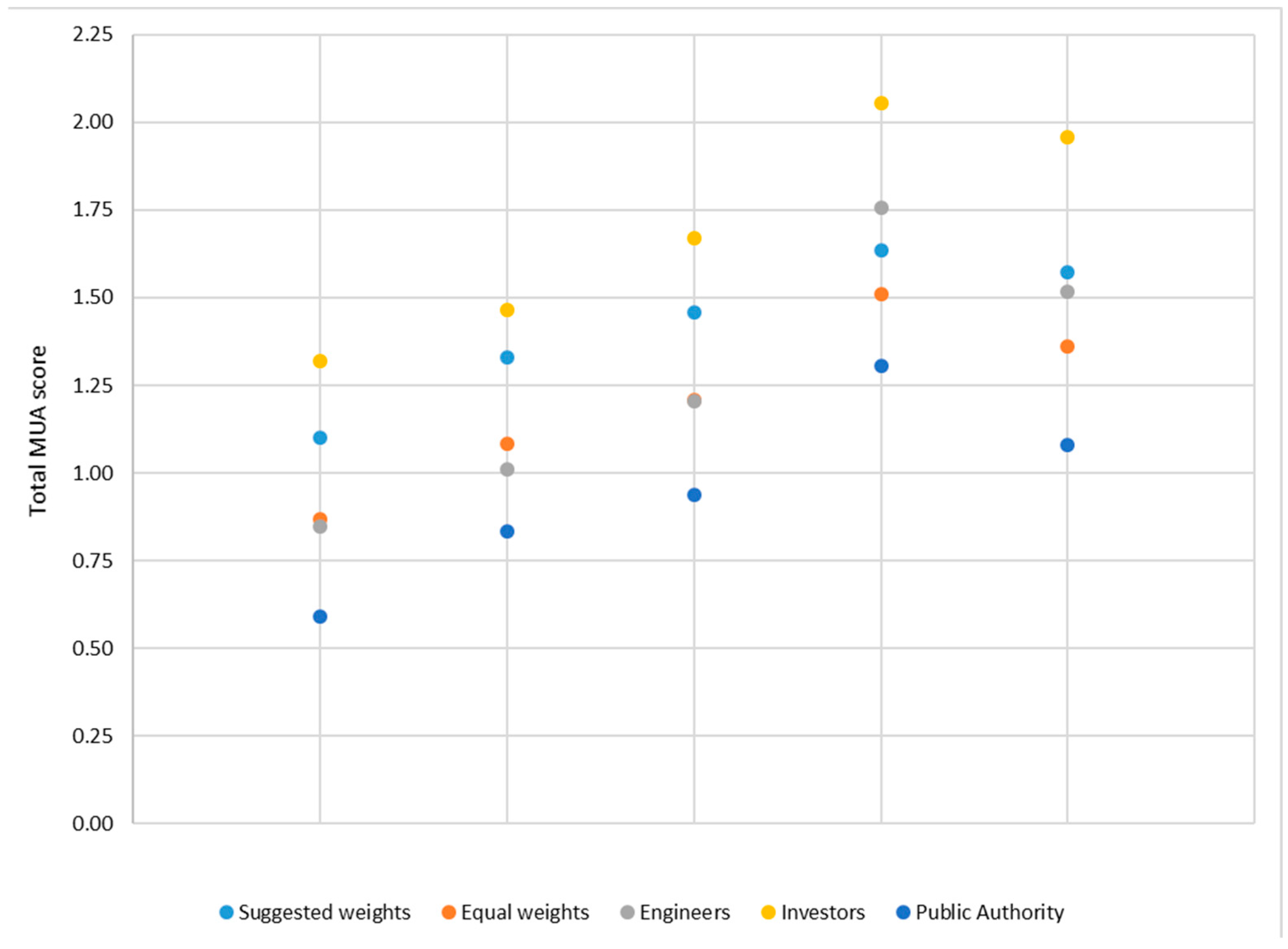A New Tool for the Sustainable Use of Marine Space
Abstract
1. Introduction
2. The Decision Support Tool for Multi-Use Areas
2.1. Overview of the Tool
2.2. The Use of the Tool for Decision-Making in Facilitation Processes
3. Description of the Tool’s Operational Steps
3.1. Preliminary Meeting and Input Parameters
3.2. Compilation of the Worksheet
3.3. Final Meeting and Output Results
4. Sensitivity Analysis of the Results
4.1. Criteria Scoring Methods
4.2. Criteria Weights
5. Discussion
- It is fully general: all the RES and activities traditionally considered for the development of offshore MUA are already implemented in the tool with a corresponding set of specific criteria. However, it also allows users to add other RES and additional activities as desired, thus enabling a wide variety of combinations to be compared.
- It is a guided, automatic, and user-friendly tool implemented in Microsoft Excel—a standard software available to most users and widely familiar. It is sufficient to select the desired options from the drop-down menus by following the provided instructions; therefore, no special knowledge or technical expertise is required.
- It is highly customizable at different levels, particularly in the method used for calculating individual scores and in the selection of the weights assigned to the different criteria.
- It aims to simultaneously consider, as comprehensively as possible, the economic, social, and environmental benefits and impacts traditionally assessed in the literature, without influencing the user’s choices and ensuring the objectivity of the final result.
- When used by a group of experts opting for an incremental scoring method, the increments are evenly distributed, based on the number of UMA included. It is currently not possible to assign a higher or lower weight to the increment associated with a specific UMA according to expert judgment.
- When applied on a large scale for broad consultations, the Excel sheet does not directly include a built-in questionnaire to account for the participants’ backgrounds. Thus, sensitivity analysis concerning individual backgrounds must be conducted separately after data collection.
6. Conclusions
Author Contributions
Funding
Data Availability Statement
Conflicts of Interest
Abbreviations
| CIA | Cumulative Impact Assessment |
| DST | Decision Support Tool |
| MCM | Multi-Criteria Methodology |
| MSP | Marine Spatial Planning |
| MUA | Multi-Use Area |
| MUA-DST | Decision Support Tool for Multi-Use Areas |
| RE | Renewable Energy |
| RES | Renewable Energy Sources |
| UMA | Uses of the Marine Area |
References
- Ehler, C.; Douvere, F. Marine Spatial Planning: A Step-By-Step Approach Toward Ecosystem-Based Management. In Intergovernmental Oceanographic Commission and Man and the Biosphere Programme; IOC Manual and Guides No. 53; ICAM Dossier No. 6 Paris; UNESCO, 2009. Available online: https://unesdoc.unesco.org/ark:/48223/pf0000186559 (accessed on 1 November 2025).
- European Union. Directive 2014/89/EU “Establishing a Framework for Maritime Spatial Planning”. In Offshore Journal of the European Union; European Union: Brussels, Belgium, 2014; L257/135; Available online: https://eur-lex.europa.eu/legal-content/EN/TXT/?uri=celex%3A32014L0089 (accessed on 1 April 2025).
- European Union. Annex III Table 2b in Directive 2017/845/EU, Amending Directive 2008/56/EU “Establishing a Framework for Community Action in the Field of Marine Environmental Policy (Marine Strategy Framework Directive)”. In Offshore Journal of the European Union; European Union: Brussels, Belgium, 2017; L125/27; Available online: https://eur-lex.europa.eu/legal-content/EN/TXT/?uri=CELEX:02008L0056-20170607 (accessed on 1 April 2025).
- CORDIS EU. H2OCEAN Project (2012–2014)—Development of a Wind-Wave Power Open-Sea Platform Equipped for Hydrogen Generation with Support for Multiple Users of Energy. 2025. Available online: https://cordis.europa.eu/project/id/288145/reporting (accessed on 1 April 2025).
- CORDIS EU. TROPOS Project (2012–2015)—Modular Multi-Use Deep Water Offshore Platform Harnessing and Servicing Mediterranean, Subtropical and Tropical Marine and Maritime Resources. 2025. Available online: https://cordis.europa.eu/project/id/288192/reporting (accessed on 1 April 2025).
- CORDIS EU. MERMAID Project (2012–2015)—Innovative Multi-Purpose Offshore Platforms: Planning, Design & Operation. 2025. Available online: https://cordis.europa.eu/project/id/288710/reporting (accessed on 1 April 2025).
- SPACE@SEA. Space at Sea Project. 2017. Available online: https://spaceatsea-project.eu/ (accessed on 1 May 2025).
- The Blue Growth Farm. The Blue Growth Farm Project—Empowering Offshore Aquaculture. 2023. Available online: https://thebluegrowthfarm.eu/ (accessed on 1 May 2025).
- CORDIS EU. MARIBE Project (2015–2017)—Marine Investment for the Blue Economy. 2025. Available online: https://cordis.europa.eu/project/id/652629 (accessed on 1 May 2025).
- MUSES. MUSES Project—Multi-Use in European Seas. 2025. Available online: https://muses-project.com/ (accessed on 1 May 2025).
- Schupp, M.F.; Bocci, M.; Depellegrin, D.; Kafas, A.; Kyriazi, Z.; Lukic, I.; Schultz-Zehden, A.; Krause, G.; Onyango, V.; Buck, B. Toward a Common Understanding of Ocean Multi-Use. Front. Mar. Sci. 2019, 6, 165. [Google Scholar] [CrossRef]
- BLUEGent. Edulis Project—Offshore Mussel Culture in Wind Farms. 2025. Available online: https://www.aqua.ugent.be/edulis (accessed on 1 April 2025).
- OLAMUR. OLAMUR Project—Offshore Low-Trophic Aquaculture in Multi-Use Scenario Realisation in North and Baltic Seas. 2025. Available online: https://olamur.eu/ (accessed on 1 May 2025).
- ULTFARMS. ULTFARMS Project—Circular Low Trophic Offshore Aquaculture in Wind Farms and Restoration of Marine Space. 2025. Available online: https://ultfarms.eu/ (accessed on 1 May 2025).
- UNITED. UNITED Project—Multi-Use Offshore Platforms DemoNstrators for BoostIng Cost-EffecTive and Eco-Friendly ProDuction in Sustainable Marine Activities. 2025. Available online: https://www.h2020united.eu/ (accessed on 1 May 2025).
- MUSICA. MUSICA Project—Multiple Use of Space for Island Clean Autonomy. 2020. Available online: https://musica-project.eu/ (accessed on 1 May 2025).
- Hammar, L.; Molander, S.; Palsson, J.; Crona, J.S.; Carneiro, G.; Johansson, T.; Hume, D.; Kagesten, G.; Mattson, D.; Tornqvist, O.; et al. Cumulative impact assessment for ecosystem-based marine spatial planning. Sci. Total Environ. 2020, 734, 139024. [Google Scholar] [CrossRef] [PubMed]
- Hansen, H.S. Cumulative Impact of Societal Activities on Marine Ecosystems and Their Services. In Computational Science and Its Applications—ICCSA 2019; ICCSA 2019. Lecture Notes in Computer Science; Misra, S., Gervasi, O., Murgante, B., Stankova, E., Korkhov, V., Torre, C., Rocha, A.M.A.C., Taniar, D., Apduhan, B.O., Tarantino, E., Eds.; Springer: Cham, Switzerland, 2019; Volume 11621. [Google Scholar] [CrossRef]
- Menegon, S.; Depellegrin, D.; Farella, G.; Sarretta, A.; Venier, C.; Barbanti, A. Addressing cumulative effects, maritime conflicts and ecosystem services threats through MSP-oriented geospatial webtools. Ocean Coast. Manag. 2018, 163, 417–436. [Google Scholar] [CrossRef]
- Stock, A. Open source software for mapping human impacts on marine ecosystems with an additive model. J. Open Res. Softw. 2016, 4, 21. [Google Scholar] [CrossRef]
- Halpern, B.S.; Walbridge, S.; Selkoe, K.A.; Kappel, C.V.; Micheli, F.; D’Agrosa, C.; Bruno, J.F.; Casey, K.S.; Ebert, C.; Fox, H.E.; et al. A global map of human impact on marine ecosystems. Science 2008, 319, 948–952. [Google Scholar] [CrossRef] [PubMed]
- Bonnevie, I.M.; Hansen, H.S.; Schroder, L. SEANERGY—A spatial tool to facilitate the increase of synergies and to minimise conflicts between human uses at sea. Environ. Model. Softw. 2020, 132, 104808. [Google Scholar] [CrossRef]
- Bonnevie, I.M.; Hansen, H.S.; Schroder, L. Assessing use-use interactions at sea: A theoretical framework for spatial decision support tools facilitating co-location in maritime spatial planning. Mar. Pol. 2019, 106, 103533. [Google Scholar] [CrossRef]
- European MSP Platform. ADRIPLAN Conflict Score Tool. 2025. Available online: https://msp-platform.eu/practices/adriplan-conflict-score-tool (accessed on 1 April 2025).
- Watts, M.E.; Ball, I.R.; Stewart, R.S.; Klein, C.J.; Wilson, K.; Steinback, C.; Lourival, R.; Kircher, L.; Possingham, H.P. Marxan with zones: Software for optimal conservation-based land and sea-use zoning. Environ. Model. Softw. 2009, 24, 1513–1521. [Google Scholar] [CrossRef]
- Kyriazi, Z.; Lejano, R.; Maes, F.; Degraer, S. A cooperative game-theoretic framework for negotiating marine spatial allocation agreements among heterogeneous players. J. Environ. Manag. 2017, 187, 444–455. [Google Scholar] [CrossRef] [PubMed]
- Zanuttigh, B.; Angelelli, E.; Kortenhaus, A.; Koca, K.; Krontira, Y.; Koundouri, P. Methodology for multi-criteria design of multi-use offshore platforms for marine renewable energy harvesting. Renew. Energy 2016, 85, 1271–1289. [Google Scholar] [CrossRef]
- Zanuttigh, B.; Palma, G.; Brizzi, G.; Bellotti, G.; Romano, A.; Suffredini, R. Design of a multi-use marine area off-shore the Mediterranean Sea. Ocean Eng. 2021, 221, 108515. [Google Scholar] [CrossRef]
- Zanuttigh, B.; Dallavalle, E.; Zagonari, F. A novel framework for sustainable decision-making on reusing Oil & Gas offshore platforms with application to the Adriatic Sea. Renew. Sustain. Energy Rev. 2025, 211, 115252. [Google Scholar] [CrossRef]
- Stuiver, M.; Soma, K.; Koundouri, P.; Van den Burg, S.; Gerritsen, A.; Harkamp, T.; Dalsgaard, N.; Zagonari, F.; Guanche, R.; Schouten, J.J.; et al. The Governance of Multi-Use Platforms at Sea for Energy Production and Aquaculture: Challenges for Policy Makers in European Seas. Sustainability 2016, 8, 333. [Google Scholar] [CrossRef]







| MUA 1 | MUA 6 | MUA 12 | MUA 16 | MUA 17 | |
| Solar energy | x | x | x | x | x |
| Wind energy | x | x | |||
| Wave energy | x | ||||
| Fish farming | x | x | x | x | |
| Tourism | x | x | x | x |
| Sub-Criterion | Calculation Method | MUA1 | MUA6 | MUA12 | MUA16 | MUA17 |
|---|---|---|---|---|---|---|
| Creation of new jobs (Benefit) | Increments | 2.50 | 2.50 | 3.00 | 5.00 | 4.50 |
| Maximum value | 3.33 | 3.33 | 3.33 | 5.00 | 5.00 | |
| Δ Total MUA score | 7.45% | 6.27% | 2.29% | 0.00% | 3.18% | |
| Maintenance—Transportation (Impact) | Increments | 3.50 | 2.90 | 4.00 | 5.00 | 4.50 |
| Maximum value | 5.00 | 4.00 | 5.00 | 5.00 | 5.00 | |
| Δ Total MUA score | −1.88% | −1.17% | −0.97% | 0.00% | −0.45% | |
| MUA16 (All UMA Including Wave Energy) | MUA17 (All UMA Except Wave Energy) | |
|---|---|---|
| Increments (Equation (5)) | ||
| Maximum value (Equation (6)) |
| Criteria | Weights | |||||
|---|---|---|---|---|---|---|
| Suggested Weights | Equal Weights | Engineers | Investors | Public Authority | ||
| Industrial benefit | Innovation | 0.4 | 0.5 | 0.5 | 0.3 | 0.6 |
| Exploitation potential | 0.6 | 0.5 | 0.5 | 0.7 | 0.4 | |
| Impacts | Environmental impact | 0.3 | 0.33 | 0.2 | 0.1 | 0.4 |
| Risks | 0.3 | 0.33 | 0.4 | 0.4 | 0.4 | |
| Costs | 0.4 | 0.33 | 0.4 | 0.5 | 0.2 | |
Disclaimer/Publisher’s Note: The statements, opinions and data contained in all publications are solely those of the individual author(s) and contributor(s) and not of MDPI and/or the editor(s). MDPI and/or the editor(s) disclaim responsibility for any injury to people or property resulting from any ideas, methods, instructions or products referred to in the content. |
© 2025 by the authors. Licensee MDPI, Basel, Switzerland. This article is an open access article distributed under the terms and conditions of the Creative Commons Attribution (CC BY) license (https://creativecommons.org/licenses/by/4.0/).
Share and Cite
Dallavalle, E.; Daprà, I.; Zanuttigh, B. A New Tool for the Sustainable Use of Marine Space. Sustainability 2025, 17, 10182. https://doi.org/10.3390/su172210182
Dallavalle E, Daprà I, Zanuttigh B. A New Tool for the Sustainable Use of Marine Space. Sustainability. 2025; 17(22):10182. https://doi.org/10.3390/su172210182
Chicago/Turabian StyleDallavalle, Elisa, Irene Daprà, and Barbara Zanuttigh. 2025. "A New Tool for the Sustainable Use of Marine Space" Sustainability 17, no. 22: 10182. https://doi.org/10.3390/su172210182
APA StyleDallavalle, E., Daprà, I., & Zanuttigh, B. (2025). A New Tool for the Sustainable Use of Marine Space. Sustainability, 17(22), 10182. https://doi.org/10.3390/su172210182








